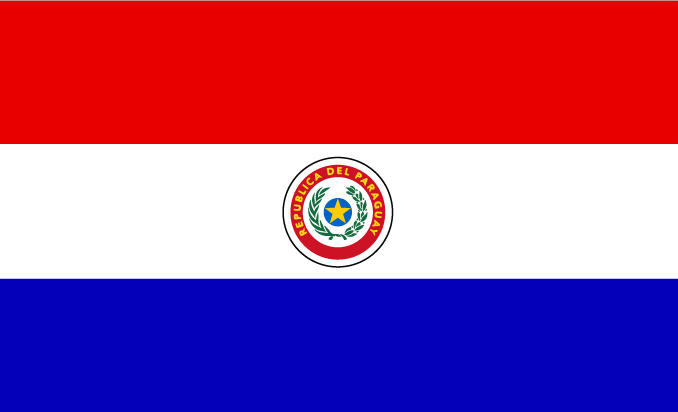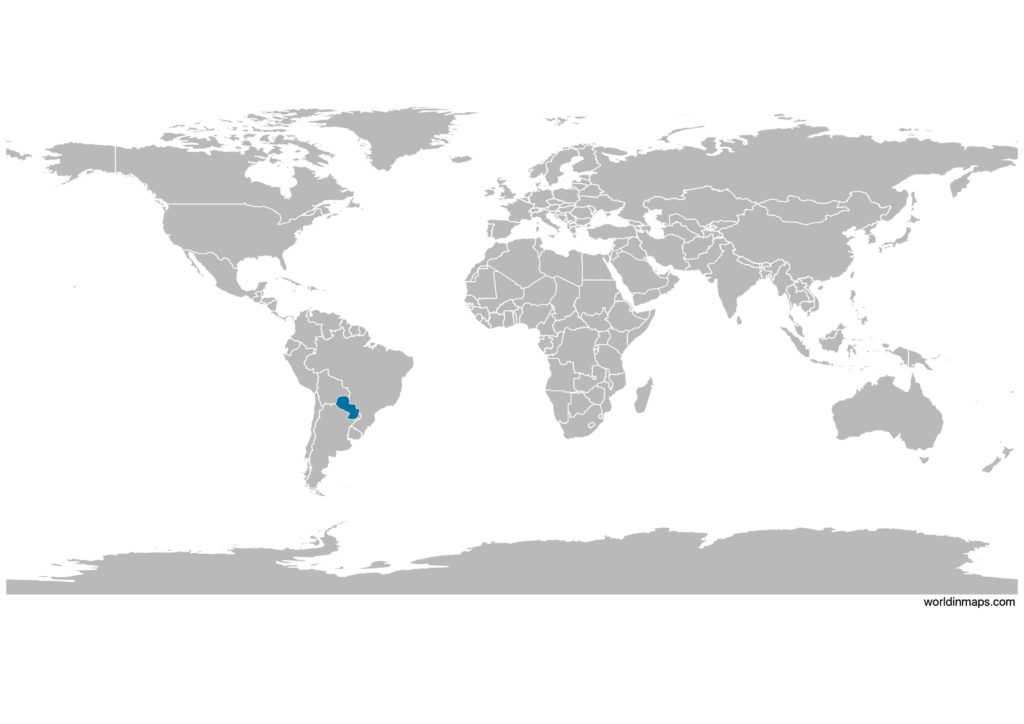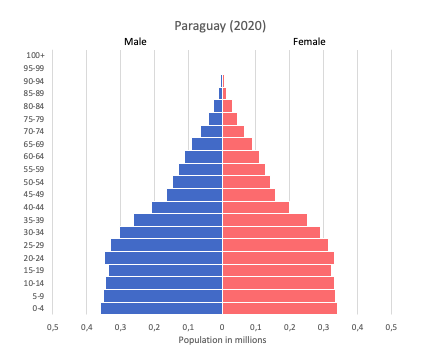Paraguay

| Government | |
| Name | Republic of Paraguay |
| Spanish | República del Paraguay |
| Guarani | Tetã Paraguái |
| Government type | presidential republic |
| Capital | Asuncion (522,287 (2019)) |
| Currency | Guaraní (PYG) |
| People | |
| Population (2020) | 7,132,530 (104th) |
| Density of population | 17.83 P/km2 (210th) |
| Nationality | Paraguayan |
| Official languages | |
| Spanish | |
| Guarani | |
| Ethnic groups | |
| mestizo (mixed Spanish and Amerindian) | 95% |
| other | 5% |
| Religions (2002) | |
| Roman Catholic | 89.6% |
| Protestant | 6.2% |
| other Christian | 1.1% |
| other or unspecified | 1.9% |
| none | 1.1% |
| Life expectancy (2020) | |
| Male | 75.2 years |
| Female | 80.7 years |
| Total population | 77.9 years (72nd) |
| Homicides | |
| Total (2018) | 7.1 per 100,000 people (45th) |
| Geography | |
| Land area | 397,302 km2 |
| water area | 9,450 km2 |
| total area | 406,752 km2 (61th) |
| Mean elevation | 178 m |
| Lowest point | |
| junction of Rio Paraguay and Rio Parana | 46 m |
| Highest point | |
| Cerro Pero | 842 m |
| Land use (2011) | |
| Agricultural land | 53.8% |
| Arable land | 10.8% |
| Permanent crops | 0.2% |
| Permanent pasture | 42.8% |
| Forest | 43.8% |
| Other | 2.4% |
| Urbanization | |
| Urban population (2020) | 62.2% |
| Rate of urbanization | 1.71% annual rate of change (2015 – 2020) |
| Economy | |
| Labor force (2017) | 3.428 million (101st) |
| Labor force by occupation (2008) | |
| Agriculture | 26.5% |
| Industry | 18.5% |
| Services | 55% |
| Unemployment rate (2017) | 5.7% (85th) |
| GDP (PPP) (estimate 2019) | |
| Total | $101.075 billion (88th) |
| Per capita | $14,131 (96th) |
| GDP (nominal) (estimate 2019) | |
| Total | $44.557 billion (94th) |
| Per capita | $6,229 (94th) |
| GDP by sector (estimate 2017) | |
| Agriculture | 17.9% |
| Industry | 27.7% |
| Services | 54.5% |
| Exports (2017) | $11.73 billion (83rd) |
| Exports partners (2017) | |
| Brazil | 31.9% |
| Argentina | 15.9% |
| Chile | 6.9% |
| Russia | 5.9% |
| Imports (2017) | $11.35 billion (95th) |
| Imports partners (2017) | |
| China | 31.3% |
| Brazil | 23.4% |
| Argentina | 12.9% |
| US | 7.4% |
Paraguay on the world map

Paraguay top 10 largest cities (2019)
- Asuncion (522,287)
- Ciudad del Este (301,815)
- Luque (277,301)
- San Lorenzo (257,530)
- Capiatá (236,828)
- Lambaré (179,800)
- Fernando de la Mora (176,943)
- Limpio (145,740)
- Ñemby (139,691)
- Encarnación (134,059)
Demography
Population pyramid

Age structure data
Estimate for 2020:
- 0-14 years: 23.41% (male 857,303/female 826,470)
- 15-24 years: 17.71% (male 640,400/female 633,525)
- 25-54 years: 42.63% (male 1,532,692/female 1,532,851)
- 55-64 years: 8.37% (male 306,100/female 295,890)
- 65 years and over: 7.88% (male 267,351/female 299,103)
Remark: the age structure of a population affects a nation’s key socioeconomic issues. Countries with young populations (high percentage under age 15) need to invest more in schools, while countries with older populations (high percentage ages 65 and over) need to invest more in the health sector. The age structure can also be used to help predict potential political issues. For example, the rapid growth of a young adult population unable to find employment can lead to unrest.
Population from 1950 to 2020
Source: United Nations, Department of Economic and Social Affairs, Population Division (2019). World Population Prospects 2019, Online Edition. Rev. 1.
Evolution of the life expectancy from 1960 to 2018
Source: World Development Indicators, The World Bank
Economy
Agriculture:
cotton, sugarcane, soybeans, corn, wheat, tobacco, cassava (manioc, tapioca), fruits, vegetables, beef, pork, eggs, milk, timber
Industries:
sugar processing, cement, textiles, beverages, wood products, steel, base metals, electric power
Exports – commodities:
soybeans, livestock feed, cotton, meat, edible oils, wood, leather, gold
Imports – commodities:
road vehicles, consumer goods, tobacco, petroleum products, electrical machinery, tractors, chemicals, vehicle parts
Time zone and current time in Paraguay
Go to our interactive map to get the current time in Paraguay